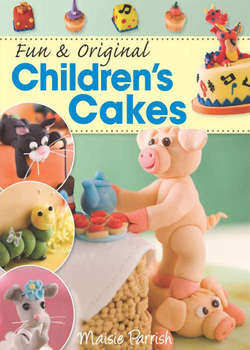Читать книгу Fun and Original Children's Cakes - Maisie Parrish - Страница 12
На сайте Литреса книга снята с продажи.
Other Recipes
ОглавлениеNow you have your sugarpaste (see pages 8–9) and your cakes (see pages 22–24) ready and waiting, there are a few other recipes you will need in order to complete the projects in this book.
Sugar Flower Paste
This is a good strong paste that can be rolled very thinly. It is ideal for making delicate objects such as butterflies and stars (see pages 61 and 113 for examples). The best sugar flower paste is bought ready-made, but you can make your own from the following recipe.
The exquisite butterflies on the Butterfly Fairy cake (see pages 58–71) were made using sugar flower paste, which can be rolled out very thinly and dries super hard so that the wings don’t flop down.
Ingredients
25ml (5tsp) cold water 10ml (2tsp) powdered gelatin 500g (1lb 1½oz) icing (confectioners’) sugar 10ml (2tsp) liquid glucose 15ml (1tbsp) gum tragacanth 15ml (3tsp) white vegetable fat (shortening) 1 egg white (or the equivalent made up from dried egg albumen)
Method
1 Place the water in a small heatproof bowl. Sprinkle the gelatin over the water and leave to soak for around 30 minutes until it becomes spongy.
2 Stand the bowl over a pan of hot water and stir until dissolved. Add the glucose and white vegetable fat (shortening) to the gelatin, and continue to heat and stir until all the ingredients have melted and mixed together.
3 Carefully sift the icing (confectioners’) sugar and gum tragacanth into the bowl of an electric mixer and fit the bowl to the machine.
4 Add the gelatin mixture to the icing (confectioners’) sugar then add the egg white. Turn the mixer on at its lowest speed. Beat until mixed and then increase the speed to maximum and continue beating until the paste is white and stringy.
5 Empty the paste out, then roll tightly in a polythene bag. Store it in an airtight container until required. It will keep for several weeks if stored correctly.
Edible Glue
This is the glue that holds sugarpaste pieces together, used in every project in this book. Always make sure your glue is edible before applying it to your cake.
Tip
Should you require stronger glue, use gum tragacanth as the base. Mix 5ml (1tsp) gum tragacanth powder with a few drops of water to make a thick paste. Store in an airtight container in the fridge.
Ingredients
1.25ml (¼tsp) CMC (Tylose) powder 30ml (2tbsp) boiled water, still warm A few drops of white vinegar
Method
1 Mix the CMC (Tylose) powder with the warm boiled water and leave it to stand until the powder has fully dissolved. The glue should be smooth and to a dropping consistency. If the glue thickens after a few days, add a few more drops of warm water.
2 To prevent contamination or mould, add a few drops of white vinegar.
3 Store the glue in an airtight container in the fridge and use within one week.
Buttercream
A generous coating of buttercream precedes the covering of sugarpaste on all sponge cakes. The classic version is flavoured with a few drops of vanilla essence, but you could substitute this for cocoa powder or grated lemon/orange zest to suit your particular taste.
Sweet and delicious, buttercream is simple to make and is the ideal covering for both large and mini sponge cakes. Smooth on a generous layer with a palette knife before they are covered in sugarpaste.
Ingredients
To make 480g (1lb) of buttercream
110g (4oz) butter (at room temperature) 30ml (2tbsp) milk 350g (12oz) sifted icing (confectioners’) sugar
Method
1 Place the butter into a mixing bowl and add the milk and any flavouring required.
2 Sift the icing (confectioners’) sugar into the bowl a little at a time. Beat it after each addition until all the sugar has been incorporated. The buttercream should be light and creamy in texture.
3 Store in an airtight container for no more than one week.
Gum tragacanth, CMC (Tylose) powder, apricot glaze and confectioners’ glaze are essential products that you will need to purchase before you begin sugarcrafting (see Suppliers, page 126).
Essential Purchases
A visit to your local cake decorating or sugarcraft shop is a must – not only can you buy all the necessary products there, you will also come away very inspired! These products cannot be made at home with any great ease, and therefore need to be purchased.
Gum tragacanth
This is a natural gum, which comes in the form of fine white powder used for thickening and strengthening sugarpaste for modelling (see page 9).
CMC (Tylose) powder
Carboxymethylcellulose is a synthetic and less expensive substitute for gum tragacanth.It is used as a thickening agent when added to sugarpaste, and also used for edible glue.
Apricot glaze
This glaze is painted on to fruit cakes before adding a layer of marzipan (see page 30). It is made from apricot jam, water and lemon juice, which is boiled then sieved. Although it would be possible to make your own, I don’t know anyone who does, as it is so easy to use straight from the jar.
Confectioners’ glaze
This product is used to highlight the eyes, shoes, or anything you want to shine on your model. It is particularly useful if you want to photograph your cake, as it will really add sparkle. Apply a thin coat and let it dry, then apply a second and even a third to give a really deep shine. It is best kept in a small bottle with brush on the lid – this way the brush is submerged in the glaze and doesn’t go hard. If you use your paintbrush to apply it, then you will have to clean it with special glaze cleaner.
